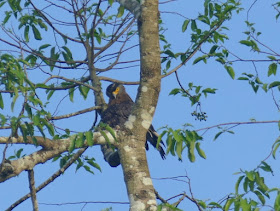As promised last time, this will be a continuation of (and conclusion to) my introduction to the rich fauna of the Kinabatangan River in Sabah, Malaysian Borneo. What follows is a combination of two river excursions on the same day, one beginning at dawn, the other in the evening. My only disappointment is that we didn't see any elephants, though people do, not infrequently.
As you can see, the primary forest comes right to the banks of the river.
 |
| A delightful creek channel off the main river, into which we ventured. |
However, as I suggested last time, this is somewhat misleading, as can be seen in some parts where the veil is particularly thin.
 |
| Oil Palms coming down to the river; this break in the generally complete forest corridor along the river is shameful, but fortunately seems to be an aberration. |
Overall though the width of the corridor is a little more than this suggests - as indicated by the view from a tower above the Myne Resort, and by the presence of big mammals (including those elusive elephants).
It was a very rewarding time on the river for wildlife, as well as the sense of being in the forest. The number and diversity of birds of prey was striking (more impressive than some of these pics, taken from a distance in a moving boat).
And from here I'm afraid the quality of raptor photos drops off somewhat...
 |
| Crested Goshawk Accipiter trivirgatus. A true goshawk, mostly of tropical forests, hunting mammals, birds and reptiles by ambush from cover. |
Kingfishers featured, as one would expect, including one which has become one of my world favourites.
 |
| (Sunlight on the lens!) Blue-eared Kingfisher Alcedo meninting; a beautiful bird closely related to the widespread Eurasian Common Kingfisher A. atthis. |
And this is Borneo, so Hornbills are a given!
The last bird photo I'm offering is purely on the basis of the subject, not the photo. Storm's Stork Ciconia stormi is close to being the rarest stork in the world; there are fewer than 350 mature birds left, with only 150 in Malaysia, mostly in Borneo. It relies on peat forest and riverine forests, which are being cleared throughout its range. I may not get the chance to take better photos of it.
 |
| Storm's Stork, above and below. |
The river is also a refuge for Estuarine Crocodiles Crocodylus porosus, and we saw some impressive ones.
 |
| Estuarine Crocodiles, above and below. This ocean-going species is found from India to northern Australia. |
And of course there will always be monkeys.
 |
| Long-tailed Macaque Macaca fascicularis; successful and ubiquitous throughout its wide south-east Asian range. |
 |
| Proboscis Monkeys Nasalis larvatus gathering in the evening in a tree with good views of approaching enemies, preparing to spend the night. For a little more on both these species, see here. |
And that pretty much ends our tour, as light is falling. I hope you get to the Kinabatangan River - and if you do, I even hope you get to see the elephants!
BACK ON THURSDAY
(And remember that you can get a reminder when the next post appears by putting your email address in the Follow by Email box in the top right of this screen.)
(And remember that you can get a reminder when the next post appears by putting your email address in the Follow by Email box in the top right of this screen.)















No comments:
Post a Comment